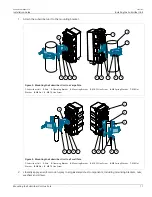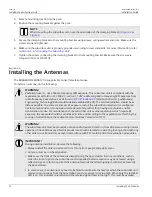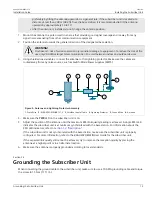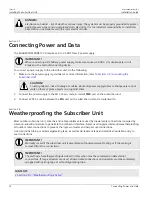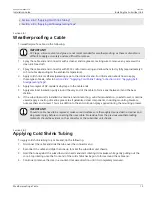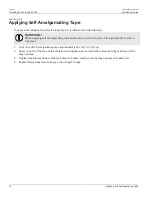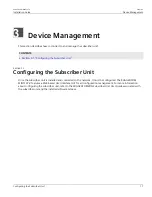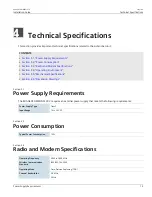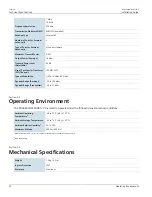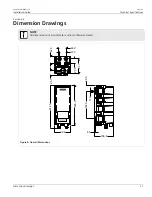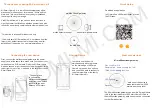
Chapter 2
Installing the Subscriber Unit
RUGGEDCOM WIN5137-V
Installation Guide
6
General Procedure
IMPORTANT!
This product should be installed in a
restricted access location
where access can only be gained by
authorized personnel who have been informed of the restrictions and any precautions that must be
taken. Access must only be possible through the use of a tool, lock and key, or other means of security,
and controlled by the authority responsible for the location.
IMPORTANT!
Install equipment in accordance with the electrical code relevant to the country of installation, such as:
• the National Electrical Code (NEC), ANSI/NFPA 70
• the Canadian Electrical Code (CEC), Part 1, CSA C22.1
• the National Electrical Safety Code IEEE C2 (when applicable)
Unless marked or otherwise identified, the Standard for the Protection of Electronic Computer/Data
Processing Equipment, ANSI/NFPA 75, also applies.
IMPORTANT!
Outdoor exposed communication lines longer than 40 m (140 ft) must be considered as TNV-1 circuits.
The installer must make sure the power supply and network ports are designed for full compliance with
the standards for TNV-1 telecommunication networks.
CONTENTS
•
Section 2.1, “General Procedure”
•
Section 2.2, “Unpacking the Subscriber Unit”
•
Section 2.3, “Site Preparation and Precautions”
•
Section 2.4, “Mounting the Subscriber Unit”
•
Section 2.5, “Installing the Antennas”
•
Section 2.6, “Grounding the Subscriber Unit”
•
Section 2.7, “Connecting Power and Data”
•
Section 2.8, “Weatherproofing the Subscriber Unit”
Section 2.1
General Procedure
The general procedure for installing the subscriber unit is as follows:
1. Review the relevant certification information for any regulatory requirements. For more information, refer to
2. Unpack and inspect the subscriber unit components. For more information, refer to
.
3. Mount the subscriber unit to a pole, wall or tower. For more information, refer to
4. Install and connect the antenna(s). For more information, refer to
Section 2.5, “Installing the Antennas”
5. Make sure the subscriber unit is grounded. For more information, refer to

















